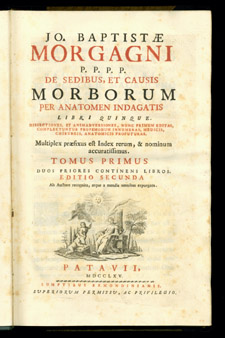Giambattista Morgagni (1682-1771)
De sedibus, et causis morborum per anatomen indagatis libri quinque. Patavii: Sumptibus Remondinianis, 1765. Fulltext online, 1766

- Giambattista Morgagni, De sedibus…. This second edition was published in 1765, four years after the first edition.
Giambattista Morgagni or Giovanni Battista Morgagni, an Italian pathologist, teacher, and anatomist, is considered one of the founders of pathological anatomy. The concept of linking a patient’s symptoms and physical findings with discoveries made upon examining the patient’s body after death did not begin with Morgagni. Galen recognized this correlation as early as the second century. However, Morgagni is notable for studying the relationship between clinical signs and postmortem discoveries in a very systematic and comprehensive way. He examined existing literature, compiled case studies, and made detailed notes of his own autopsies. The resulting work, De sedibus et causis morborum per anatomen indagatis, was published in 1761 when he was 79 years old and includes the records of nearly 700 postmortem examinations. Morgagni’s monumental work was instrumental in the overthrow of Galenic humoral pathology.
Morgagni was very thorough in his written description of cancer, kidney stones, liver cirrhosis, and the pathology of the vascular system. His descriptions of aneurysms are particularly good.
De sedibus is arranged according to the organs in which the principal lesions are found. The 1765 edition has an exceptionally valuable index. The “Index Secundus” with the subheading of “Morbos, & Symptomata exhibens, illorumque externas causas, aetates extremas, vitae genus, artes, & alia ejusmodi” indexes diseases and exhibiting symptoms, their external causes, the last stages of life, kind of life, skills, and other things of this type.
More than 60 years after De sedibus was first published, a second English translation with additional notes was completed by William Cooke, a London surgeon. In the preface of The Seats and Causes of Diseases, Investigated by Anatomy he writes: “…and it has been universally acknowledged, that, owing to the greater accuracy of his details, this collection of dissections is far more valuable than any which preceded it; nor am I acquainted with any parallel work which has subsequently appeared.” [Morgagni v]
next author: William Cheselden (1688-1752).

